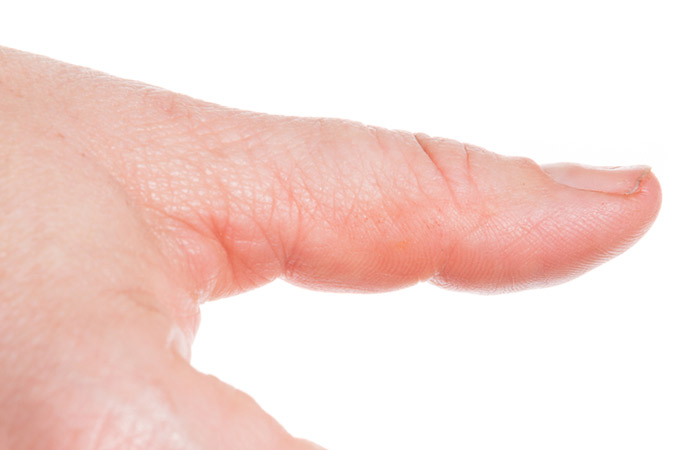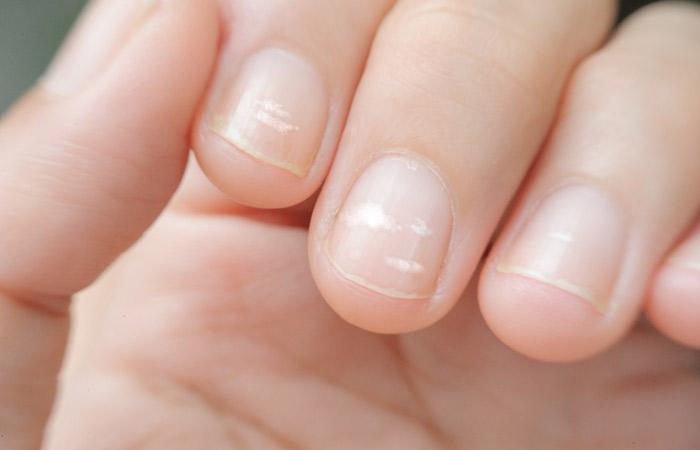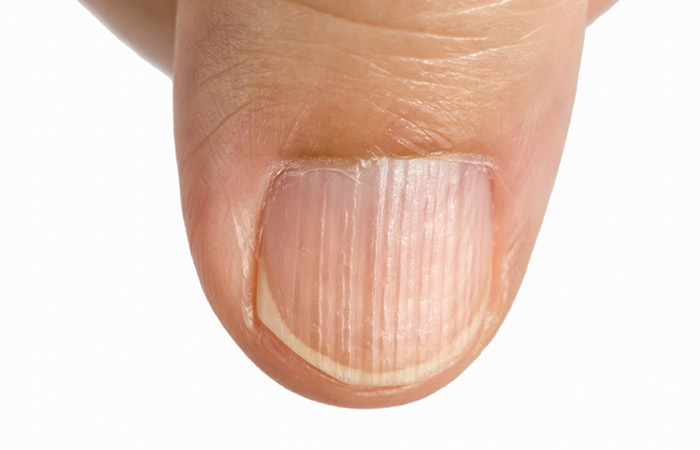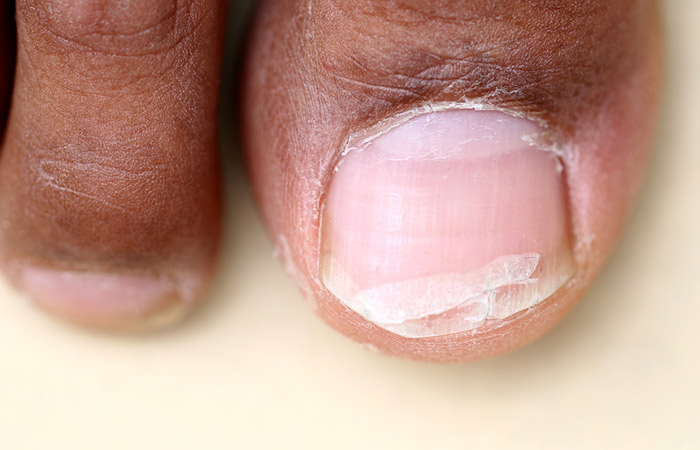
Image: Shutterstock
Our fingernails reveal a lot about our overall health. For instance, if you have a vitamin deficiency, nails may become brittle, weak, rough, and lose their smoothness. So, if you have weak and brittle nails, if they are not growing properly, or have grooves on them, instead of rushing for expensive nail treatments, check if your body lacks crucial vitamins and minerals. Luckily, a healthy and balanced diet can fix nutritional deficiencies, or you may also take supplements. Here, we have listed the symptoms of common nail issues and what they indicate. Scroll down.
10 Nail Conditions And Symptoms To Watch Out For
- Koilonychia Or Spoon-shaped Nails
- Beau’s Lines
- Onychorrhexis (Longitudinal Ridging Of Nails)
- Leukonychia
- Splinter Hemorrhages
- Vertical Ridging Of Nails
- Hapalonychia (Soft Nails)
- Clubbing
- Pallor Of Nail Bed
- Melanonychia
1. Koilonychia Or Spoon-shaped Nails
How To Identify
- The nails are extremely thin and have a spoon-like shape.
- The outer edges of the nails turn up and come out of the nail beds.
- The nails may crack.
- The shape of the nail becomes such that it can hold a drop of water.
What Causes It?
Iron deficiency (or anemia) is the most common cause of Koilonychia. Lack of iron in your body makes the nails brittle (1). If this condition is caused due to anemia, you may also notice other symptoms, such as:
- Fatigue
- Weakness
- Pale skin
- Shortness of breath
However, this condition can also be caused by:
- Your body’s inability to absorb nutrients
- External trauma to the nail
- Excessive exposure to detergents and petroleum solvents
- Radiation therapy or chemotherapy
It can also be hereditary or caused by environmental factors. A study found that people living in higher altitudes often experience this condition (2).
How To Fix It
With Food
If anemia or iron deficiency causes your condition, consuming food items rich in iron is a way to combat it.
Foods that can help you overcome Koilonychia include:
- Pork
- Poultry
- Beans
- Red meat
- Peas
- Dark green leafy veggies
- Dry fruits such as apricots and raisins
Medicines And Other Treatment Options
Compared to vegetables and other sources, your body can easily absorb iron from poultry and meat. However, if you are a vegan, the doctor may prescribe iron supplements, along with vitamin B12 supplements.
 Did You Know?
Did You Know?2. Beau’s Lines
How To Identify
- Horizontal depressions on your nails.
- May occur on the fingernails or thumbnails or toenails or all nails.
- The ridges keep growing as the nail grows.
What Causes It?
Zinc deficiency often causes Beau’s lines (1). However, other associated causes of this condition include:
- Injury to the nail
- Inflammatory conditions, such as psoriasisi
- Nail plate infection
- Excessive picking at cuticles or nails (manicure may also cause Beau’s lines)
- Certain drugs (mostly chemotherapy agents)
- An illness that comes with high fever (such as scarlet fever, pneumonia, measles, and mumps)
How To Fix It
Beau’s lines usually go away as your nails grow (unless your nails receive further injury).
With Food
If your condition is caused due to zinc deficiency, consume foods high in zinc, such as:
- Red meat
- Oyster and shellfish
- Legumes (such as beans and chickpeas)
- Seeds (such as flaxseeds, hemp, and pumpkin seeds)
- Cashew nuts
- Eggs
- Dairy products
Medicine And Other Treatment Options
In case Beau’s lines are caused by any other underlying health issue, the doctor will diagnose and treat it accordingly. Often, treating the underlying medical condition helps in making the lines disappear. Consult your doctor immediately if you see these lines on your nails.
3. Onychorrhexis (Longitudinal Ridging Of Nails)
How To Identify
- Longitudinal ridges appear on the nails.
- Your nails become extremely brittle and start splitting at the ends.
What Causes It?
This condition is commonly seen in people with anorexia nervosai , malnutrition, and irregular eating habits and is attributed to poor food, water, and nutrient intake. Deficiency of iron, calcium, and zinc causes Onychorrhexis (1).
Other causes of brittle nails include:
- Psoriasis
- Eczemai
- Excessive use of nail polish remover or cuticle solvents
- Injury to the nail
- Prolonged exposure to detergent, soap, and alcohol
Dr. Anna Chacon, MD, FAAD, a board-certified dermatologist, says, “Your nails are thinner, weaker, and brittler when your body doesn’t get enough calcium. You could see that they shatter quickly and don’t appear to be as robust as they once were. Even though the components of bones and nails are different, they are similar enough that having difficulties with your nails might be a sign of issues with your bones’ density.”
How To Fix It
With Food
Have food items that are rich in vital nutrients, especially iron, calcium, and zinc. These include:
- Dairy products
- Seeds (chia, sesame, and poppy seeds)
- Cheese
- Fish such as salmon and sardines
- Lentils and beans
- Whey protein
- Almond
- Dark green leafy vegetables
Medicine And Other Treatment Options
Doctors may prescribe retinoid drugs (for oral intake) to treat brittle nails, depending on the underlying cause of your condition. Mostly, self-care measures can help improve the condition of your nails.
4. Leukonychia
How To Identify
- Small white spots on your nail bed (punctate leukonychia).
- White longitudinal bands on your nails (longitudinal leukonychia).
- Horizontal lines or bands on your nail (transverse leukonychia).
- White skin patches under the nail (partial leukonychia).
What Causes It?
Deficiencies of calcium, zinc, and B vitamins are the main causes of this condition (1). Treatment with these vitamins has reportedly helped in treating this condition.
However, other factors may also cause Leukonychia. They include:
- Excessive nail biting
- Nail injuries
- Manicures
- A side effect of drugs (chemotherapy drugs and sulphonamides)
- Illness (anemia, liver scarring, diabetes, and eczema)
- Hereditary causes
How To Fix It
With Food
If the condition is caused due to nutrient deficiency, including these nutrients in your diet can help cure it. Consume these foods:
- Dairy products
- Dark green leafy vegetables
- Whole grains
- Legumes
- Seeds
- Eggs
- Meat
Medicine And Other Treatment Options
If nutrient deficiencies cause the condition, it will be gone when your body gets an adequate supply of those nutrients. Usually, the white spots go away as your nails keep growing. If the condition is caused by any other underlying condition (an injury or illness), it needs to be treated separately.
5. Splinter Hemorrhages
How To Identify
- These look like thin red, brown, or blackish lines under the nails.
- They run longitudinally, along the direction of your nail growth.
What Causes It?
These are mostly caused by trauma (injury to the small blood vessels underneath the nail bed). However, splinter hemorrhage is also caused by vitamin C deficiency (in some cases).
How To Fix It
With Food
If vitamin C deficiency is the reason behind the condition, include these foods in your diet:
- Brussels sprouts
- Broccoli
- Green leafy veggies
- Spinach
- Tomatoes
- Sweet and white potatoes
- Citrus fruits
Medicine And Other Treatment Options
Since in most of the cases, splinter hemorrhages are caused by injuries or infections, healing the injury or infection will heal your nail automatically. However, your doctor may conduct laboratory tests, such as blood culture (to detect any bacterial or fungal infection). Sometimes, such hemorrhage under the nails may indicate a type of melanomai . If your doctor suspects melanoma, they may also conduct a biopsy.
 Trivia
Trivia6. Vertical Ridging Of Nails
How To Identify
- Longitudinal furrows or ridges running right from the tips of your nails to the cuticles.
What Causes It?
- Aging (this is very common in older adults due to low cell turnover)
- Vitamin deficiency (especially B vitamins that promote cell growth)
- Injury or trauma to the nail
Dr. Chacon says, “There are various reasons why your fingernails may have ridges, including renal and thyroid disorders, stress, and many more. Vertical nail ridges may increase in number or prominence as we age due to changes in the nail’s cell turnover.”
How To Fix It
With Food
A balanced diet rich in all essential vitamins and nutrients is key to eliminate vertical ridging. This is a fairly common issue and can be easily treated. Have a balanced diet that includes:
- Vegetables
- Whole grains
- Dairy products
- Fish and seafood
- Meat and poultry products
Medicine And Other Treatment Options
The doctor may give you nutrient supplements to make up for the nutrient deficiency. Apart from that, self-care is also important to avoid any unnecessary injury to the nails.
7. Hapalonychia (Soft Nails)
How To Identify
- The top of the nails become thin and soft. They bend and are extremely brittle.
What Causes It?
Hapalonychia, also known as eggshell nails, is caused due to malnutrition, especially the deficiency of vitamins A, B6, C, and D. Low calcium level is also one of the causes of this condition (3).
How To Fix It
With Food
The best remedy for this condition is by getting proper nutrients through food. Consume lots of:
- Fresh vegetables
- Cereals
- Dairy products
- Fish liver oil
- Fruits
- Saltwater fish (these are a rich source of micronutrients)
Medicine And Other Treatment Options
The doctor may prescribe vitamin and biotin supplements. Also, avoid any nail cosmetics and nail procedures (manicures) if you see that you have soft nails.
8. Clubbing
How To Identify
- The nail bed softens, and the nail is not firmly attached to the nail bed.
- The tip of the finger may seem bulging.
- The nails curve downward and look round at the edges or just like a spoon that’s turned upside-down.
What Causes It?
Iodine deficiency may cause clubbing of nails sometimes. However, clubbing is also associated with:
- Low oxygen levels in the blood
- Lung disease
- Inflammatory bowel syndrome
- Cardiovascular or liver disease
How To Fix It
With Food
Include food sources rich in iodine and other nutrients in your diet, such as:
- Iodized salt
- Tuna
- Shrimp
- Seaweed
- Prunes
- Eggs
- Dairy
- Lima beans
Medicine And Other Treatment Options
Nail clubbing may indicate other serious health ailments, such as lung and heart issues. So, if you notice these symptoms, consult a doctor immediately. Treating these health conditions will help in reducing the nail deformity.
9. Pallor Of Nail Bed
How To Identify
- Pale fingernails (excessive discoloration)
What Causes It?
Anemia is the most common cause of pallor of the nail bed. This condition is associated with low levels of iron in your body.
How To Fix It
With Food
A diet change is the best way to deal with anemia that causes pallor of nail beds. Design a diet plan to combat anemia and consume these foods:
- Green leafy veggies (kale, spinach, Swiss chard)
- Meat and poultry
- Seafood (fresh salmon, halibut, tuna, and sardines)
- Calcium-rich foods, such as broccoli, tofu, cheese, kefir, and yogurt
- Beans
- Nuts and seeds
Medicine And Other Treatment Options
The doctor may conduct a Complete Blood Count (CBC) test and prescribe iron supplements.
10. Melanonychia
How To Identify
- Brown or black lines on your nails.
- It looks like a vertical strip that starts at the bottom of your nails and continues to the top.
- It may occur in one or multiple nails.
What Causes It?
Often, melanonychia is caused due to malnutrition and lack of essential proteins and energy in your body. The melanocytes deposit melanini on the nail bed, and that is why you see those longitudinal strips on your nails. Apart from malnutrition, several other factors may activate the melanocytes. They include:
- Trauma and injury
- Infection
- Psoriasis
- Hyperthyroidismi
- Photosensitivityi
- Tobacco
- Henna
- Exposure to X-ray
- Excess iron in the body
How To Fix It
With Food
If your condition is caused due to malnutrition, eating healthy is the only way to reduce the pigmentation on your nails. Consume:
- Red meat (but in limited quantities)
- Eggs
- Cheese and milk
- Fresh vegetables (especially leafy greens)
- Seasonal fruits
- Tofu
- Nuts and seeds
- Seafood
- Whole grains
Medicine And Other Treatment Options
Treatment options for melanonychia depend on its cause. If the cause is an infection, the doctor may give you antifungal medicines and antibiotics.
Taking good care of your nails is equally important. Here’s a list of a few dos and don’ts to keep your nails in good condition.
Nail Care – Dos And Don’ts
Do
- Clean your fingernails and keep them dry. This prevents any bacterial growth under the nails.
- Use rubber gloves when using harsh chemicals and detergents to wash the dishes. Minimizing contact with these chemicals and water will prevent split fingernails.
- Keep the nails trimmed and use a moisturizer to massage the cuticles and the fingers.
- Apply a nail hardener if your fingernails are too soft – this prevents breakage.
Do Not
- Bite your nails or pick the cuticles. This makes way for bacteria and fungi to enter and infect the nails.
- Use nail polish remover and other nail chemicals excessively. This can make them brittle. Even when using a remover, use one that doesn’t contain acetone.
- Excessively file your nails. This may split the nails.
- Use your fingernails to poke into things or open anything.
- Tear or pull any hangnails as it may cause infection.
Infographic: Nail Conditions And Their Main Causes
Weak and brittle nails are often signs of vitamin and nutrition deficiency. There are several nail conditions that may affect you if you do not consume enough vitamins and minerals.
Though we have already discussed all the major and minor causes of nail conditions, you should check out the infographic below to learn which vitamin or mineral deficiency causes which condition.

Illustration: StyleCraze Design Team
Vitamin deficiency may result in weak and brittle nails. Lack of essential vitamins, minerals, and proteins may cause melanonychia, leukonychia, splinter hemorrhages, beau’s lines, onychorrhexis, and koilonychia. These conditions may cause symptoms like nail plate infection, nail injury, white spots and patches on your nails, and longitudinal furrows. Consuming a healthy diet with pork, beans, red meat, dark green veggies, almond, whey protein, dairy products, eggs, legumes, seeds, and fruits may help heal vitamin deficiency nails. You may also fix this condition with medicines and other treatment options.
Frequently Asked Questions
Can B12 deficiency affect your nails?
Yes, vitamin B12 deficiency can result in an unusual darkening of the nails or perhaps a bluish color if left untreated for too long.
Why don’t I have half-moons on my fingernails?
The half-moon shapes on their fingernails are called lunulae. It is a part of the nail matrix and contains the blood vessels, nerves, and lymph. However, lunulae may or may not be visible, and their appearance often indicates underlying conditions.
Do thyroid problems cause nail ridges?
Yes, thyroid dysfunction is one of the many factors that may cause nail ridges.







